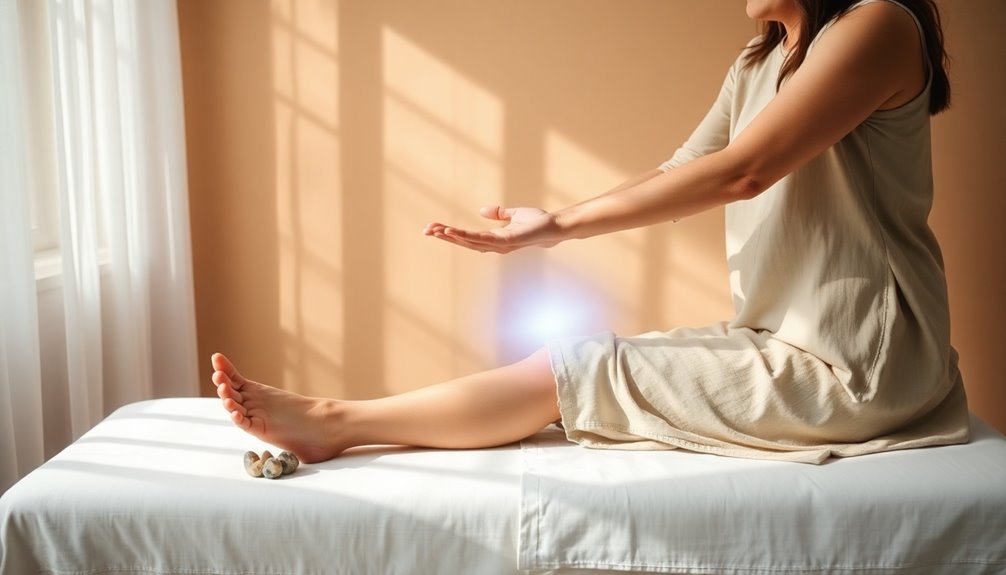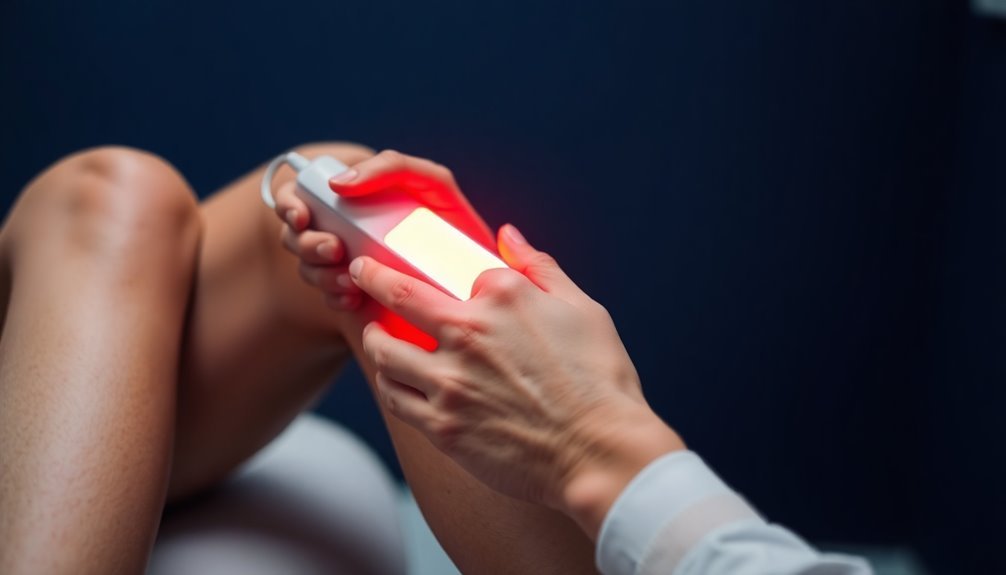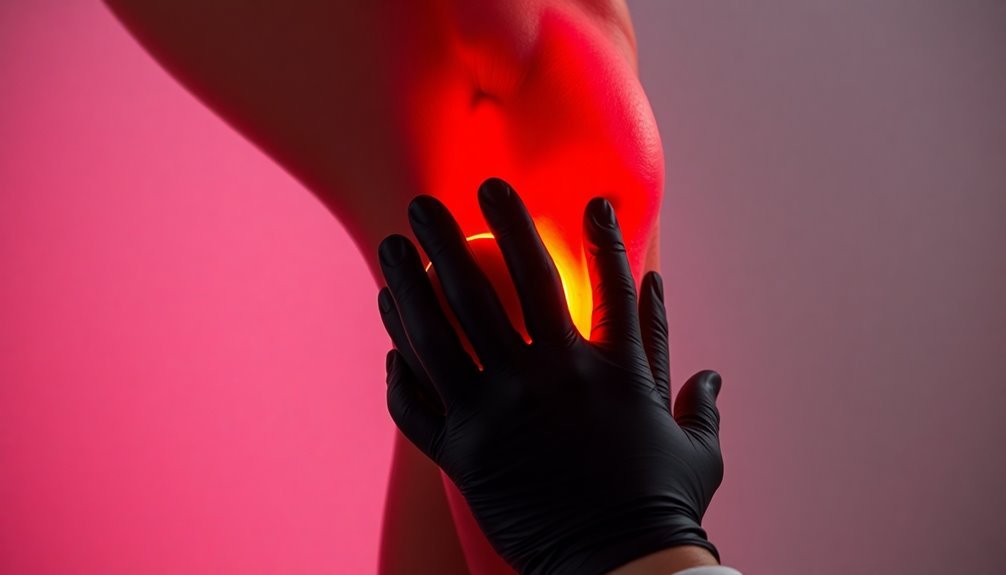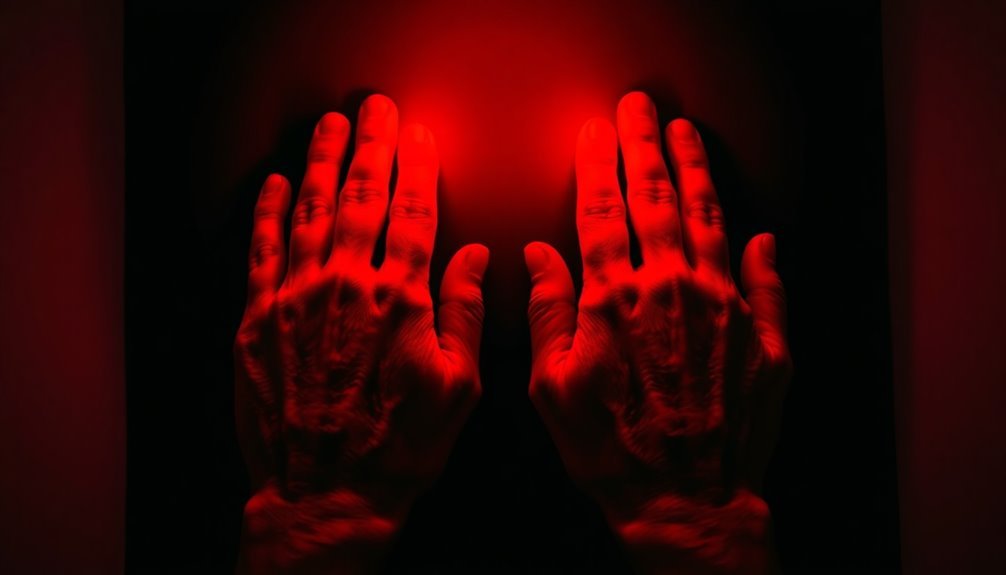Deep-penetrating energy therapy offers you a natural solution for joint pain by stimulating your body's healing mechanisms at the cellular level. You'll experience improved range of motion and significant pain relief through treatments that combine laser technology and LED panels featuring red and near-infrared wavelengths. The therapy penetrates deep into your joints, increasing blood flow, oxygen delivery, and lymphatic circulation while reducing inflammation-causing hormones. Quick 3-5 minute sessions can provide lasting relief, with most people needing just 4-6 treatments for thorough results. Understanding how this innovative therapy works will help you make an informed decision about your joint health management.
What Makes Energy Therapy Different

Energy therapy's unique approach to joint pain sets it apart from conventional treatments. Unlike traditional methods that often focus solely on symptom management, energy therapy works by stimulating your body's natural healing mechanisms at the cellular level.
You'll find that these treatments penetrate deep into your joints, increasing blood flow, oxygen delivery, and lymphatic circulation – all essential elements for healing and pain reduction. Studies have shown that patients experience pain reductions over 50% with consistent treatment.
What truly distinguishes energy therapy is its thorough healing approach. When you undergo treatments like red light therapy, you're benefiting from enhanced mitochondrial activity and cellular proliferation while simultaneously reducing inflammation-causing hormones like bradykinin.
The therapy's ability to deliver healing photons directly to your joint tissue creates a powerful healing environment that conventional treatments can't match.
You'll discover various forms of energy therapy, from hands-on approaches like Reiki and therapeutic touch to targeted treatments like red light therapy. Each modality offers unique benefits, with some focusing on physical healing while others address both physical and psychological aspects of pain management.
This dual-action approach makes energy therapy a valuable option for those seeking natural joint pain relief.
The Science Behind Joint Healing
Through decades of research, scientists have uncovered remarkable mechanisms behind joint healing that are revolutionizing treatment approaches. Your joints possess natural repair capabilities, driven by molecular changes that activate stem cells and promote cartilage regeneration. When you're dealing with joint pain, your body's healing response includes controlling inflammation and activating specific growth factors like FGF2 and TGFß. Studies have shown that reducing mechanical stress through specialized treatments can stimulate the body's natural repair processes.
| Healing Mechanism | Key Components | Benefits |
|---|---|---|
| Cartilage Repair | Growth factors (FGF2, TGFß) | Rebuilds damaged tissue |
| Stem Cell Response | BMP2, VEGF signals | Creates new cartilage cells |
| Inflammation Control | Gene therapy, nanoparticles | Reduces pain and swelling |
Recent breakthroughs have shown that joint distraction therapy can lead to sustained improvements in knee health, while innovative biomaterials now mimic your joints' natural environment to enhance healing. You'll be interested to know that scientists are developing non-invasive treatments using nanoparticle delivery systems to target inflammatory sites directly. These advancements could help you avoid joint replacement surgery and maintain better mobility through natural healing processes.
Professional Treatment Process

Building on our understanding of joint healing mechanisms, professional treatment processes offer targeted solutions for your joint pain.
During a typical treatment session, you'll lie down or sit comfortably while the healthcare provider positions the deep tissue laser over your affected joints or muscles. These sessions are brief, lasting only 3-5 minutes, and you'll likely need 4-6 treatments to achieve thorough results.
The treatment uses specialized equipment combining laser technology and LED panels, featuring both red (660nm) and near-infrared wavelengths. These systems can cover treatment areas up to 9×14 inches, ensuring extensive coverage of your affected joints.
You'll experience a warm tingling sensation during the procedure, and there aren't any side effects to worry about.
Your healthcare provider will develop a personalized treatment plan based on your specific condition. They'll consider any underlying health issues and medications you're taking before starting treatment.
Most patients undergo therapy for about 10 weeks, with noticeable improvements appearing after just a few sessions. The laser energy stimulates your cells to increase ATP production, reducing inflammation and improving joint mobility naturally.
Benefits For Joint Health
Deep-penetrating energy therapy offers remarkable benefits for joint health through its multi-faceted approach to healing. You'll experience improved range of motion as inflammation decreases, allowing your joints to move more freely. The therapy's ability to penetrate deep into tissues enhances blood flow and oxygenation, accelerating your body's natural healing processes. Studies show that high-intensity laser therapy provides superior relief compared to traditional treatments for knee osteoarthritis patients.
Key benefits you'll notice include significant pain relief and faster recovery from injuries. The therapy's varying frequencies target specific healing needs – from 50 Hz for reducing inflammation to 5 Hz for deep tissue regeneration. This customizable approach guarantees you receive the most effective treatment for your specific joint condition.
| Frequency | Benefit |
|---|---|
| 5 Hz | Deep tissue regeneration |
| 50 Hz | Anti-inflammatory effects |
| 1000 Hz | Pain relief (analgesia) |
| Mixed | Extensive healing |
| Variable | Enhanced circulation |
You'll find that deep-penetrating energy therapy outperforms many traditional physical therapy methods, particularly in pain management. The treatment stimulates cellular activity, promoting tissue repair and cartilage regrowth. When combined with other natural remedies like essential oils or acupuncture, you'll experience even more extensive relief from joint pain and improved overall joint function.
Safety And Recovery Guidelines

When using light therapy for joint pain relief, you'll need to wear protective eyewear and follow the device manufacturer's recommended treatment duration to prevent burns or skin irritation.
You should start with shorter sessions of 5-10 minutes to test your skin's reaction and gradually increase treatment time based on your tolerance. The therapy uses low-level red light that penetrates deep into tissues without causing damage.
After each session, give your treated areas adequate rest time, and if you notice any unusual redness or discomfort, reduce your next session's duration or consult your healthcare provider.
Safety During Treatment Sessions
Safety remains paramount when using natural joint pain relief treatments, particularly during individual therapy sessions. You'll need to follow specific protocols to guarantee both effectiveness and protection during your treatment. Start by using only FDA-approved devices and carefully follow the manufacturer's guidelines for duration and frequency. Near-infrared light can provide deep tissue penetration when treating joint pain.
| Safety Measure | Action Required |
|---|---|
| Eye Protection | Wear protective eyewear or keep eyes closed during treatment |
| Skin Distance | Maintain recommended device-to-skin distance per manual |
| Time Control | Set a timer to avoid exceeding prescribed session length |
| Emergency Plan | Keep phone nearby; know when to stop treatment |
Monitor your body's response during each session, and don't hesitate to stop if you experience unusual discomfort. If you're taking medications, especially those causing photosensitivity like lithium or tretinoin, consult your healthcare provider before starting treatment. You'll want to begin with shorter sessions to test your skin's reaction, gradually increasing duration as tolerated.
Keep track of any side effects, such as skin irritation or headaches, and adjust your treatment accordingly. If you experience severe reactions, discontinue use immediately and seek medical attention. Remember, consistency in following safety protocols will help maximize benefits while minimizing risks.
Recovery Time and Rest
Recovery from joint pain requires a systematic approach that balances treatment frequency with adequate rest periods.
You'll typically need 3 to 5 treatment sessions to notice significant improvement in your pain levels. Each session lasts just 5 to 10 minutes, making it convenient to fit into your schedule.
Your treatment plan will be customized based on your specific condition. If you're dealing with acute joint pain, you might need daily treatments, while chronic conditions usually require 2 to 3 sessions per week. Using therapy before your workouts can enhance strength gains and athletic performance. There's no downtime after treatment – you can return to your normal activities immediately.
The healing effects don't stop when you leave the clinic. Your body continues to respond to the treatment for 18 to 24 hours afterward, as the therapy stimulates ATP production, increases blood flow, and reduces inflammation.
This ongoing cellular response helps repair and regenerate damaged tissue.
You'll likely experience both immediate and gradual improvements. While some pain relief may occur right after treatment, the most noticeable results typically develop after several sessions.
Following your personalized treatment schedule and post-care instructions will help guarantee the best recovery outcomes.
Alternative Pain Management Options
Managing joint pain doesn't always require medication, as numerous alternative treatments offer effective relief without pharmaceutical intervention. Deep Penetrating Light Therapy (DPLT) and Photobiomodulation Therapy (PBMT) use specific wavelengths of light to stimulate cellular repair and enhance healing at the joint level.
These high-tech options work alongside traditional alternatives like acupuncture and massage therapy to reduce inflammation and improve circulation. Cold and heat therapy can also provide immediate relief when applied to affected joints.
You'll find that essential oils such as lavender, peppermint, and eucalyptus can provide natural anti-inflammatory benefits when applied topically.
Complementary practices like biofeedback and relaxation techniques, including meditation and yoga, help you manage pain by teaching you to control your body's response to discomfort.
For hands-on treatment, you can explore physical therapy or chiropractic care to correct misalignments and strengthen supporting muscles. LED light therapy offers another non-invasive option, increasing blood flow and promoting tissue repair.
Before starting any alternative treatment, you'll want to discuss these options with your healthcare provider, as some natural remedies may interact with existing medications or affect medical devices you're using.
Frequently Asked Questions
How Many Treatment Sessions Are Typically Needed Before Seeing Significant Improvement?
You'll typically notice improvements after 3 to 5 treatment sessions, though some results may be immediate. Your body continues benefiting from each session for 18-24 hours as cellular activity promotes healing.
Can I Combine Deep-Penetrating Energy Therapy With Other Pain Management Treatments?
Yes, you can safely combine deep-penetrating energy therapy with other treatments like medications, physical therapy, and acupuncture. It's actually recommended, as these combinations can enhance your overall pain relief and healing results.
What Is the Average Cost per Session for Deep-Penetrating Energy Therapy?
You'll typically pay between $300 and $600 per session for deep-penetrating energy therapy. If you're in an urban area, expect higher costs, but you can save money by purchasing multi-session packages.
Are There Any Age Restrictions for Receiving This Type of Therapy?
You'll need to be 18 or older, or have a legal guardian's consent if you're under 18. Always consult with your healthcare provider first, as age-related health conditions may affect treatment suitability.
Does Insurance Typically Cover Deep-Penetrating Energy Therapy Treatments?
You'll typically need to pay out-of-pocket since most insurance companies don't cover deep-penetrating energy therapy. While low-level laser therapy may have limited coverage, advanced forms rarely receive insurance support for treatments.
In Summary
Now you've learned how deep-penetrating energy therapy offers a natural alternative for managing joint pain. You'll find this treatment combines well with other holistic approaches while providing targeted relief through controlled energy waves. Whether you're dealing with chronic arthritis or acute injuries, you can explore this gentle yet effective option under professional guidance. Remember to follow safety protocols and maintain realistic expectations for your healing journey.





Leave a Reply